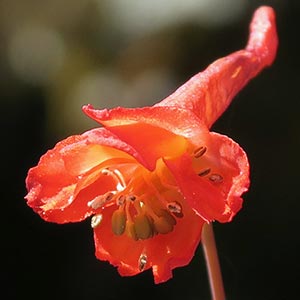Delphinium nudicaule
Delphinium carolinianum
canyon delphinium, canyon larkspur, orange larkspur, red larkspur, red or orange larkspur, scarlet larkspur
Carolina larkspur
(15-)20-50(-125) cm;
base reddish, glabrous.
(20-)40-90(-150) cm;
base reddish or not, ± pubescent.
blade round to pentagonal, 2-6 × 3-10 cm; ultimate lobes 3-12, width 5-40 mm (basal), 2-20 mm (cauline).
blade round to pentagonal, 1-8 × 2-12 cm, pubescence variable; ultimate lobes 3-29, width 2-10 mm (basal), 1-7 mm (cauline).
5-20(-69)-flowered;
pedicel (1.5-)2-6(-8) cm, glabrous to glandular-pubescent;
bracteoles 14-20(-30) mm from flowers, green to red, linear, 2-4(-9) mm, glabrous to puberulent.
(3-)8-27(-94)-flowered;
pedicel (0.4-)0.7-1.8(-5.7) cm, nearly glabrous to glandular;
bracteoles 1-3.5(-6) mm from flowers, green or blue, linear, 2-7 mm, pubescence nearly glabrous to glandular.
sepals scarlet to reddish orange, rarely dull yellow, glabrous, lateral sepals forward-pointing to form pseudotube, (6-)8-13(-16) × 3-6 mm, spurs straight, slightly ascending, (12-)18-27(-34) mm;
lower petal blades elevated, exposing stamens, 2-3 mm, clefts 0.5-1 mm;
hairs sparse, evenly dispersed, yellow.
sepals purple to blue to white, nearly glabrous, lateral sepals spreading, (7-)9-14(-17) × (3-)3.5-6(-8) mm, spurs ± upcurved, ascending 20-90° above vertical, (9-)11-17(-19) mm;
lower petal blades ± covering stamens, 5-7 mm, cleft 2-4 mm;
hairs centered, densest near base of cleft, white, sometimes blue or yellow.
13-26 mm, 3.5-4.5 times longer than wide, glabrous.
(10-)12.5-18.5(-27) mm, 4-4.5 times longer than wide, glabrous to puberulent.
unwinged or sometimes slightly wing-margined;
seed coat cells with surfaces smooth.
seed coat cells with surfaces pustulate or smooth.
= 16.
Delphinium nudicaule
Delphinium carolinianum
Delphinium nudicaule hybridizes with most other taxa of Delphinium that it encounters. Apparent hybrids involving D. nudicaule, and seen by the author (either afield or as specimens), include D. andersonii, D. antoninum, D. decorum, D. luteum, D. nuttallianum, D. patens, and D. trolliifolium. In addition, garden-grown plants have been hybridized with D. cardinale, D. elatum, D. menziesii, D. parishii, D. penardii, D. tatsienense Franchet, D. triste Fischer ex de Candolle, and D. uliginosum; D. nudicaule does not naturally occur with these species. Delphinium nudicaule is one of the earliest larkspurs to flower in any given locality. Douglas's type collection of D. nudicaule represents plants (synonyms D. sarcophyllum Hooker & Arnott and D. peltatum Hooker, an invalid name) grown under very moist conditions, probably quite near the ocean. The type specimen of D. armeniacum A. Heller represents plants grown under unusually dry conditions.
The Mendocino Indians consider Delphinium nudicaule a narcotic (D. E. Moerman 1986).
(Discussion copyrighted by Flora of North America; reprinted with permission.)
Subspecies 4 (4 in the flora).
(Discussion copyrighted by Flora of North America; reprinted with permission.)
1. Basal leaves absent at anthesis, cauline leaves divided into many narrow (less than 2 mm wide) segments, blade not distinctly 3-parted; distalmost petiole less than 5 mm; sepals usually blue or purple (rarely white). | subsp. carolinianum |
1. Basal leaves usually present at anthesis, and/or cauline leaf lobes usually wider than 2 mm, blade often distinctly 3-parted or more; distalmost petiole more than 5 mm; sepals blue or white. | → 2 |
2. Leaf blade distinctly 3-parted with few additional divisions; sepals blue to white; roots usually ± vertical, often without major branches. | subsp. vimineum |
2. Leaf blade with 3–5 or more major divisions, each further divided into segments; sepals white to very pale blue; roots ±horizontal with several major branches. | → 3 |
3. Stems usually less than 45 cm; in thin soils over limestone in clearings of deciduous woods; leaf blade with 3 major divisions; e of Mississippi River. | subsp. calciphilum |
3. Stems usually more than 45 cm; in deeper soils in grasslands; leaf blade with 5 or more major divisions; w of Mississippi River. | subsp. virescens |


